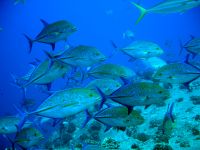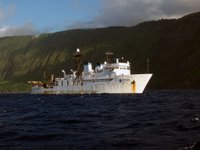
Two days ago we were off Kaula Rock, southwest of the island of Niihau. Rising from the sea like some ancient gray cathedral, this mass of pyroclastic rock was once used as a live fire target by the US Navy. Today is home to monk seals and an amazing variety of bird life. More similar in appearance to some of the Northwestern Hawaiian Islands than any of the main eight, Kaula drops off steeply into the abyss. It took all our talent just to stay close enough to shore to conduct our surveys. The wind was whipping our little boat and even at idle speed we were taking waves over the bow and sides every few minutes.

Still further west was a feature known to us only as Five Fathom Bank or Five Fathom Pinnacle. Denoted on the chart simply as a number "5." Rusty mentioned it as a site he had dived about 8 years ago and seemed to remember it being nice. It was decided that we should attempt to place some instruments on the site and possibly conduct an REA survey. After completing our last survey at Kaula Rock, the Tow-Team set of across the ocean to the west, in search of this mysterious feature. After a bit of searching we came to an area of discolored water and larger waves, indicating a pinnacle below. Rusty and I were up in the dive rotation and prepared to make the first dive. The current was screaming over the top of the pinnacle and we motored well upstream before we rolled over the side. Hitting the water we immediately headed for the bottom to catch the pinnacle as we flew past. Rising from the ocean floor 200 feet below, the
pinnacle comes to within 35 feet of the surface. As we dropped we were able to swim into the eddy downstream and grab onto the rock. Seventy-five feet or so in diameter, the pinnacle provided a good shield from the current.

Once we had stabilized and had a chance to look around it became clear Rusty had been downplaying the whole affair. The scene was spectacular. Almost beyond words. Clouds of fish surrounded us everywhere we looked, at time obscuring other areas of the pinnacle. Big fish, tiny fish, and everything in between. Jacks, Mentos Triggers, Rainbow Runners, Unicorns, Splitfins, Sharks (little ones), Surgeonfish, Angels, and Monk Seals. It was amazing! We spent close to 20 minutes clinging to the rock wall bordering a narrow channel between the pinnacle and a smaller one not far away. A school of 20 or more Whitemargin Unicorns, rare in Hawaii, were hanging in the current, offering a tail flick every now and again to answer our desperate fin kicks and acrobatics just to hold position. The Monk Seals were ever present curious of our every move. Without a doubt, this was the best dive in Hawaii. Having covered 124 miles underwater so far this expedition, that is saying a lot.
None of us can wait to return to retrieve the instruments we left there this year.









